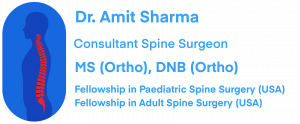Best Spine Surgeon in Mumbai | Dr. Amit Sharma

+91-9967600461
draks777@gmail.com
Recent Advances
The future of spine surgery is bright due to latest spine surgery techniques. New technologies and biological advances work in concert with minimally invasive techniques. Several of these, such as computer-assisted spine surgery techniques, endoscopic spine surgeries, and minimally invasive spine surgeries are worthy of discussion.
These techniques not only make spine surgery safer, but also create minimum soft tissue damage for a quick recovery. Hospitals stay and the time taken to resume normal activities is significantly reduced. Even a complex spine deformity correction surgery gives very predictable results due to computer navigation assisted safe and precise instrumentation, and neuromonitoring assessment of spinal cord functions during the surgery.
Improved implants: Titanium implants provide better fusion rates, are resistant to infection and compatible for an MRI scan. Minimally invasive implants and specialized retractors allow a fusion surgery to be performed with minimal soft tissue damage. Better biomechanics of the implant allow them to hold the bone until fusion takes place. Specific pedicle screws (cannulated cement screws, coated screws) are available for osteoporotic bones to provide better hold in weak bones. Stand-alone cervical cages reduce throat irritation caused by anterior cervical plates. Improved metallurgy allows reducing dimensions of the implants without compromising implant strength.
Plastic Cages: Radiolucent cages made up of medical grade plastic, poly ether ether ketone (PEEK), are not seen on x-ray. This allows fusion happening around cages better seen on x-ray.
Biodegradable Implants: Implants made of Polylactic Acid (PLA) degrade in the body over time. These implants fix the bone until fusion takes place and then gradually vanish. This helps in reducing implant related complications (infection, skin and muscle irritation).
Bone Graft: Spine fusion surgeries need bone graft for bone healing. Bone graft can either come from own body (autograft), cadaveric bone (allograft) or synthetic calcium granules. Bone Morphogenetic Proteins (BMP) is a powerful bone healing molecule. It is used for complex and revision spine surgeries to ensure fusion between vertebrae.
Disc Replacement: A disc replacement procedure preserves motion at operated levels. This causes minimal loss of spine flexibility and reduced chances of adjacent segment degeneration.
Future prospects: Tissue engineering may allow regeneration of disc tissue in lab which can be re-implanted in patients. This might help in early cases of disc degeneration. Further advances in biomaterial and design of implant are constantly happening. All these technologies developed in last decade result in smaller incision, minimal tissue damage, safe surgeries, faster healing time, better fusion rates and quicker return to normal functions.